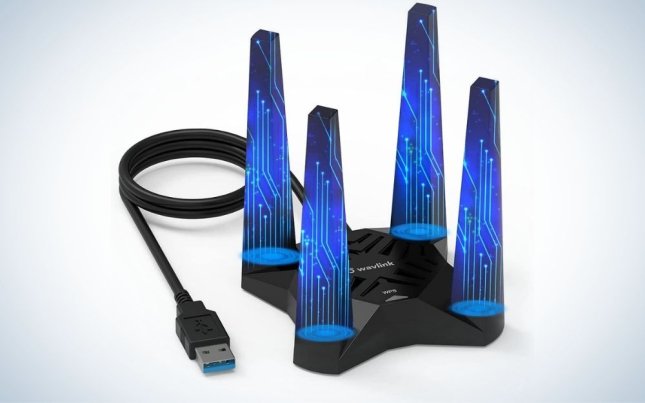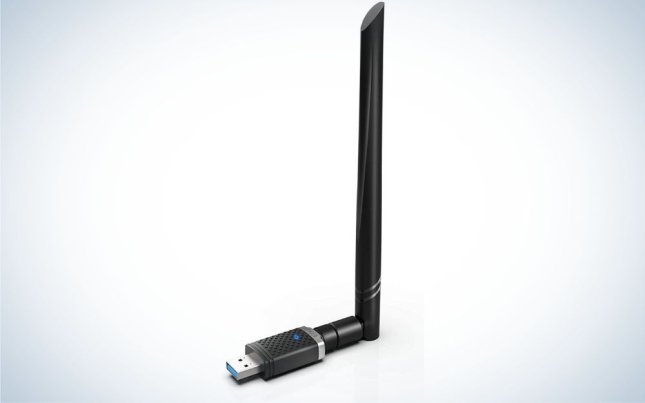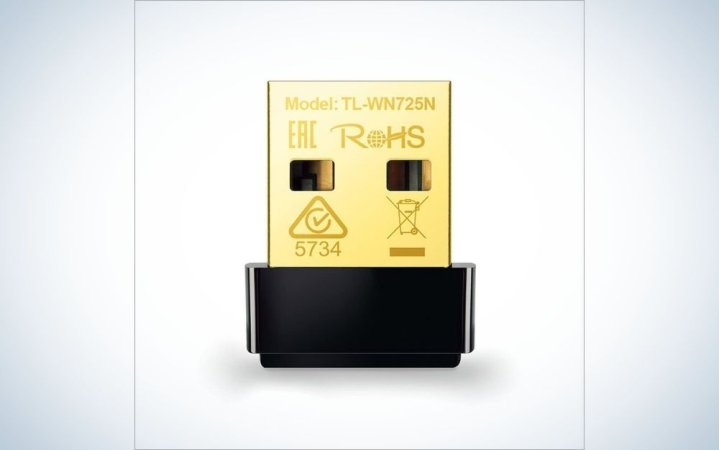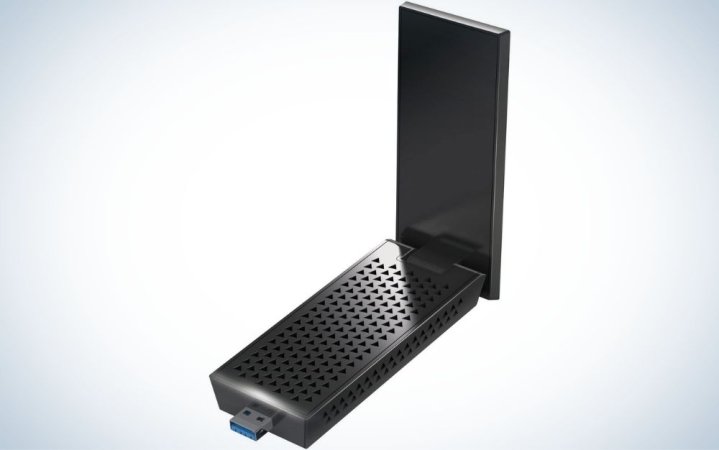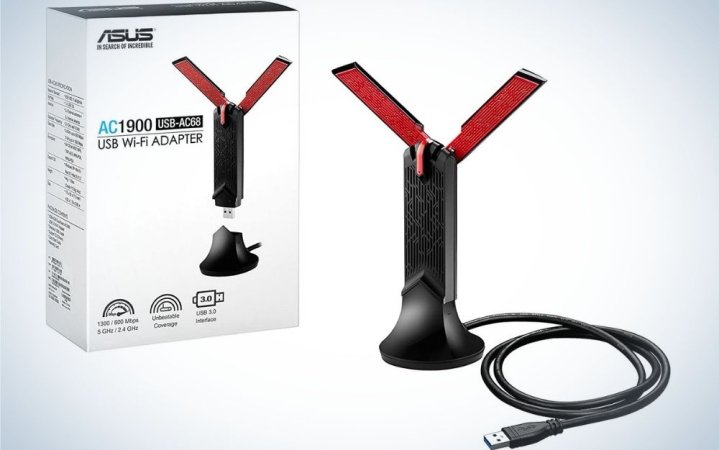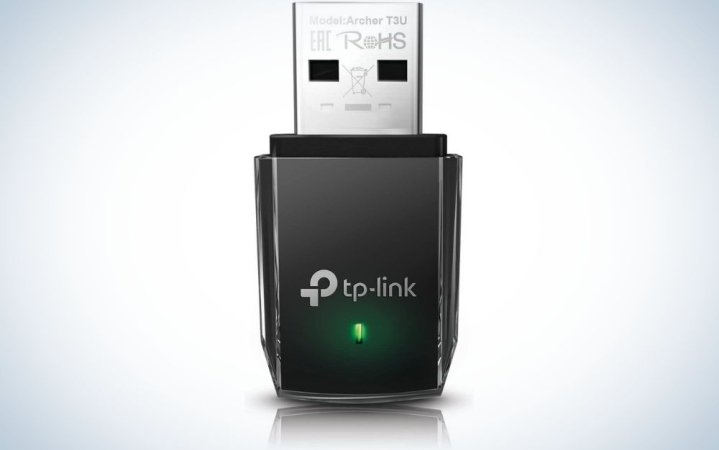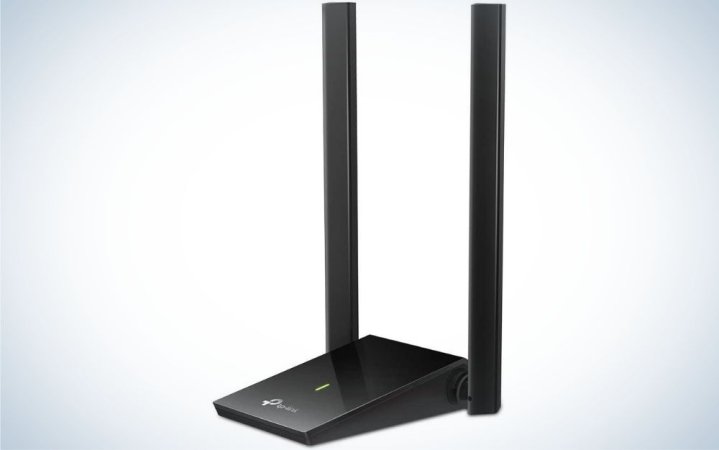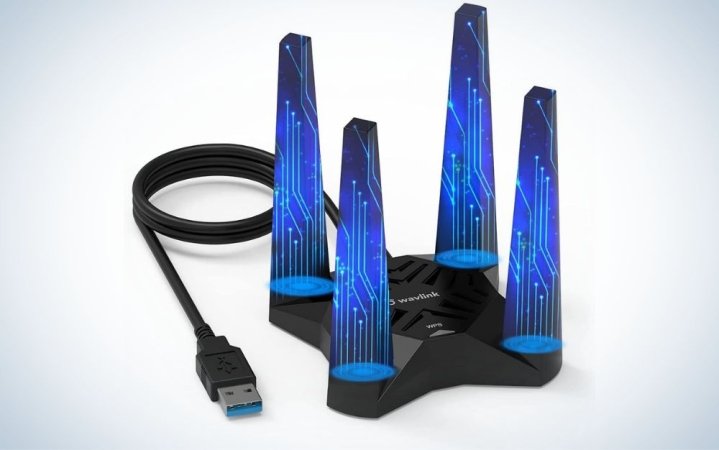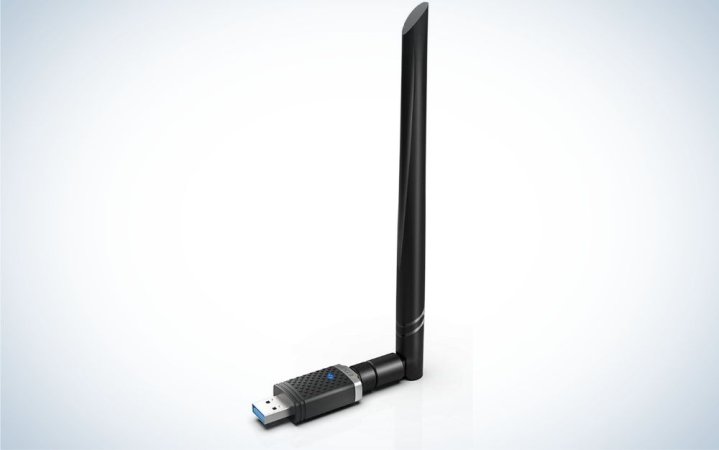We may earn revenue from the products available on this page and participate in affiliate programs. Learn more ›

WiFi adapters, at their core, add WiFi to all kinds of different devices through a simple USB port. There are many reasons why you might want one. Many desktop computers, especially older ones, don’t have internal WiFi cards. You could install one, but there’s really no need: a USB WiFi adapter will be similarly priced, with similar effectiveness, and far easier to set up. Perhaps your computer does have WiFi, but it’s on the fritz, and that’s an expensive repair. No need! Grab a USB WiFi adapter. But what do you really need, and which is the best WiFi adapter on the market?
- Best small: TP-Link N150
- Best budget dual-band: TP-Link AC600
- Best high-end dual-band: Netgear AC1900
- Best AC-rated: ASUS USB-AC68
- Best budget high-AC: TP-Link Archer T3U
- Best long-range: TP-Link Archer T4U Plus
- Best for gaming: WAVLINK WiFi Adapter
- Best budget: EDUP WiFi Adapter
The best WiFi adapters: Reviews & Recommendations
Best small: TP-Link N150
The Tiniest Adapter
If you’re looking for a portable WiFi adapter that you’ll barely notice, the TP-Link N150 is a good option. It’s compatible with both Windows and Mac OS, it’s incredibly small and affordable, and for most computers, all you need to do is plug-and-play. (For others, TP-Link has drivers you can download.) The range and speeds are lower than other options, however.
Best budget dual-band: TP-Link AC600
Great Value
If you’ve got a little more space, or are comfortable with an antenna sticking out, we love the TP-Link AC600. It’s got both 2.4GHz and 5GHz bands, is compatible with both Windows and Mac OS, and it’ll connect far from your router, all for a great price.
Best high-end dual-band: Netgear AC1900
Tons of Power
If you want faster speed for, say, a gaming PC, check out the Netgear AC1900. It has four internal antennae, supports the AC1900 standard for insanely fast speeds, and can be used in two ways. It can plug directly into your computer, or you can set it up on a magnetic dock.
Best AC-rated: ASUS USB-AC68
Super Speed
This ASUS WiFi adapter, which can either sit in a dock or plug directly into a USB port, boasts an AC1900 rating, which is about as fast as you can get. It’s not cheap, but the multi-antenna system and high-end features like beamforming, which focus the signal, mean that this is a top option.
Best budget high-AC: TP-Link Archer T3U
Budget Speed
Though this tiny adapter clocks in at under $20, it’s rated at AC1300, a wholly respectable speed. It also packs features like beamforming and MU MIMO, which are designed to make for a less laggy experience. Owing to the size, it won’t have the range of larger options.
Best long-range: TP-Link Archer T4U Plus
Internet Everywhere
If you’re concerned about range, we like USB WiFi adapters that connect to your computer with a cable. This allows you to place the adapter anywhere you want, for better reception. The TP-Link Archer T4U Plus is a great external WiFi adapter option.
Best for gaming: WAVLINK WiFi Adapter
Laser Speed
You may not need anything specific for gaming, but we like the WAVLINK WiFi Adapter for a few reasons. First, it has a high AC1900 rating, plus four antennae for fast and reliable speed. It supports both Windows and Mac OS, for the Mac gamers out there. And, well, it looks gamer-y. Neon and such.
Best budget: EDUP WiFi Adapter
Budget King
You may not know the name EDUP, but look, these aren’t complicated gadgets, and reviewers love the high speed this gadget gets from its AC1300 rating. It also has an antenna for better coverage, making it perfect for desktops, but it’s still slim enough that laptop users can plug it in without feeling bulky.
Things to consider when shopping for the best WiFi adapters
WiFi adapters come in many shapes, sizes, and price points. So what should you look for in the best WiFi adapter?
WiFi adapter size
Bigger is sometimes better, at least when it comes to network adapters like WiFi adapters. You can think of these like old-school cell phones: the larger the antenna, the more capable the WiFi adapter will be at connecting farther away from the hotspot. But that doesn’t mean you should necessarily be looking for the biggest adapter on the market. In fact, sometimes you shouldn’t be.
If you’re shopping for a WiFi adapter for a desktop, and you have plenty of space on a desk for an alien-looking gadget, then sure, go nuts with the biggest WiFi adapters out there. But if space is at a premium, especially if you’re going to be using the adapter with a laptop, you’ll want something as small as possible. These are sometimes called “micro” or “nano” adapters, and they’ll be anywhere from the size of a USB thumb drive to barely bigger than the metal part of the USB plug itself. The performance of these won’t be quite as good in terms of speed and range, but for some uses, like in laptops, that’s okay; space is more important.
What’s your favorite band?
Let’s talk bands. Not musicians, but radio frequencies. WiFi is a type of electromagnetic radiation, which might sound scary, but, well, you know what else is electromagnetic radiation? Light. Just regular sunlight. Not scary! Well, unless you don’t have sunscreen on. Anyway, this radiation is measured in frequency, which is the pattern that the light waves move up and down. WiFi, like other kinds of waves (radio, microwaves, cell service) uses a particular frequency, which enables your device to snag onto it and not get confused by any other invisible frequencies.
WiFi, these days, comes in two frequencies: 2.4GHz and 5GHz. The higher the number, the shorter the waves are, which means you can cram more waves into the same space. That also means higher speeds for WiFi. It’s likely that your home router can transmit both 2.4GHz and 5GHz. But it isn’t all about speed: 2.4GHz is also capable of covering a larger area, which makes it nice for big backyards and offices. Ideally, you want a USB WiFi adapter that has both, so you’re covered no matter what.
AC? What’s that?
No matter what kind of adapter you’re looking for, whether it’s a high-end gaming WiFi adapter or an affordable adapter, you’re going to encounter some weird specifications. One of the codes that you’ll see up front is AC, followed by some number, like 600, 1300, or 1900. You’ll probably notice that the higher that number goes, the more expensive the WiFi adapter gets, so, well, it’s probably some indication of quality, right?
The answer is “kind of, but not really.” AC, in this case, refers to WiFi 5, which is actually not the newest version of the WiFi standard; WiFi 6 came out a couple of years ago, but it’s only just now becoming common in devices. (WiFi 6’s code is “AX.”) These WiFi 5/AC adapters are the most modern USB WiFi adapters you can find, as the newer AX ones are really only available as internal chips.
The number that follows AC is a bit confusing. It does technically represents speed, but it’s the theoretical highest speeds that the hardware can achieve, which you’re not actually likely to see in real world usage. Plus, for dual-band WiFi adapters, that number is calculated by adding the maximum speeds on 2.4GHz to the maximum speeds on 5Ghz. So sure, your adapter might be rated at 1300, but you’re not going to see 1300Mbps speeds: it’s more likely that the maximum speeds are, say, 400Mbps on 2.4GHz, and 900Mbps on 5GHz. At best. So while this figure can be a nice guide, it’s not the most informative specification.
Range
Any good WiFi adapter, whether it’s a cheap adapter or the best WiFi adapter for PCs on the entire market, should work well if you’re sitting right next to your router. But that just isn’t how any of our setups really work. There are walls, there are doors, there are rooms in between. You might be outside while the router is inside. (The reverse seems unlikely, but sure, maybe that too.) You’ve got other gadgets sending off all kinds of wireless signals.
Ideally, if you’ve got the space, you’ll want to invest in an adapter that’s capable of receiving and broadcasting WiFi signals over a large, broad range. You don’t want to have to move your computer from one room to another just to get WiFi. One way to make this easier would be with a mesh WiFi setup, but ensuring you have good range on your WiFi adapter can also really help.
What about gaming?
Here’s the thing: WiFi can be fast or slow, laggy or smooth, with great reception or speeds that slow you down
Gaming requires fast upload and download speeds; so you can stream, communicate, and play with no lag at all. That doesn’t mean that you specifically need a gaming-focused product, but you do need something quite fast. Look for an AC1900 rating, and something with nice big antennae.
Best on a budget: What you get for under $20
This is a great gadget for budget-conscious shoppers. For under $20, you can get a great, high-speed WiFi adapter; there are plenty of AC1300-rated adapters out there in this price range, in a variety of different shapes. You can snag one in a nano form-factor, a thumb-drive size, or get one with a nice antenna for more range.
You’ll be giving up some extras, of course, but those aren’t too important. You’re unlikely to find an AC1900 rating at this price point, nor will you find a magnetic dock or a four-antenna setup. But if you just want to add speedy WiFi to your computer, that’s easily achievable in this price range.
FAQs
USB WiFi adapters certainly can be better than internal ones, but most modern internal WiFi adapters are quite good. The best use case for a USB WiFi adapter is if you don’t have WiFi currently or need to improve your speeds.
Unfortunately, no, WiFi adapters cannot be used in place of a router. They may look similar, but routers have totally different software and hardware.
Without doing individual testing, it’s hard to know which WiFi adapter is fastest. But you can look at some of the specifications for hints: an AC1900 adapter is likely going to be faster than an AC600.
A final word on shopping for the best WiFi adapters
WiFi adapters are magical little devices: where once there was no internet, you can simply plug in and get connected. If you use our guide to antennae and speed specifications, you can find a great WiFi adapter for you.

